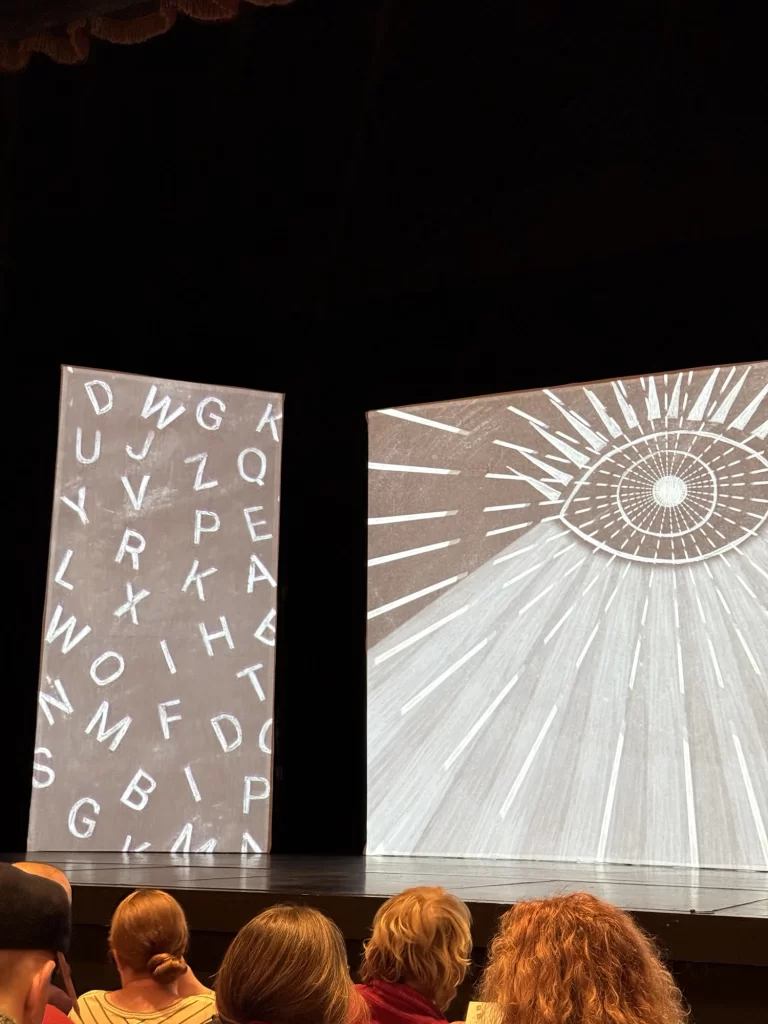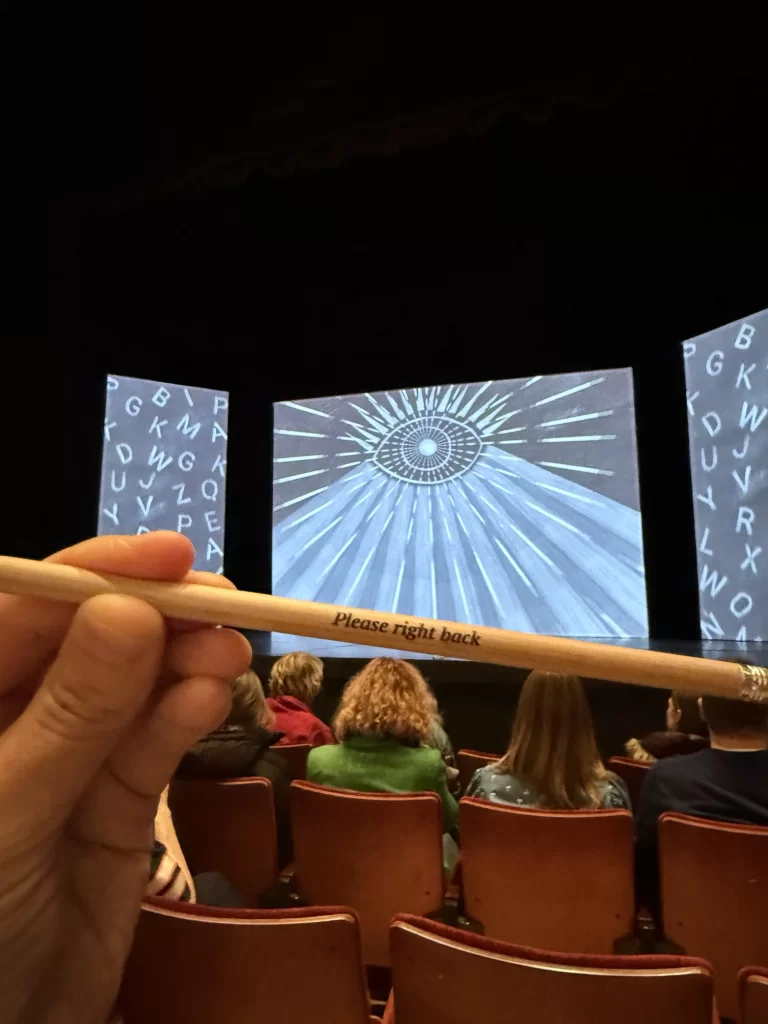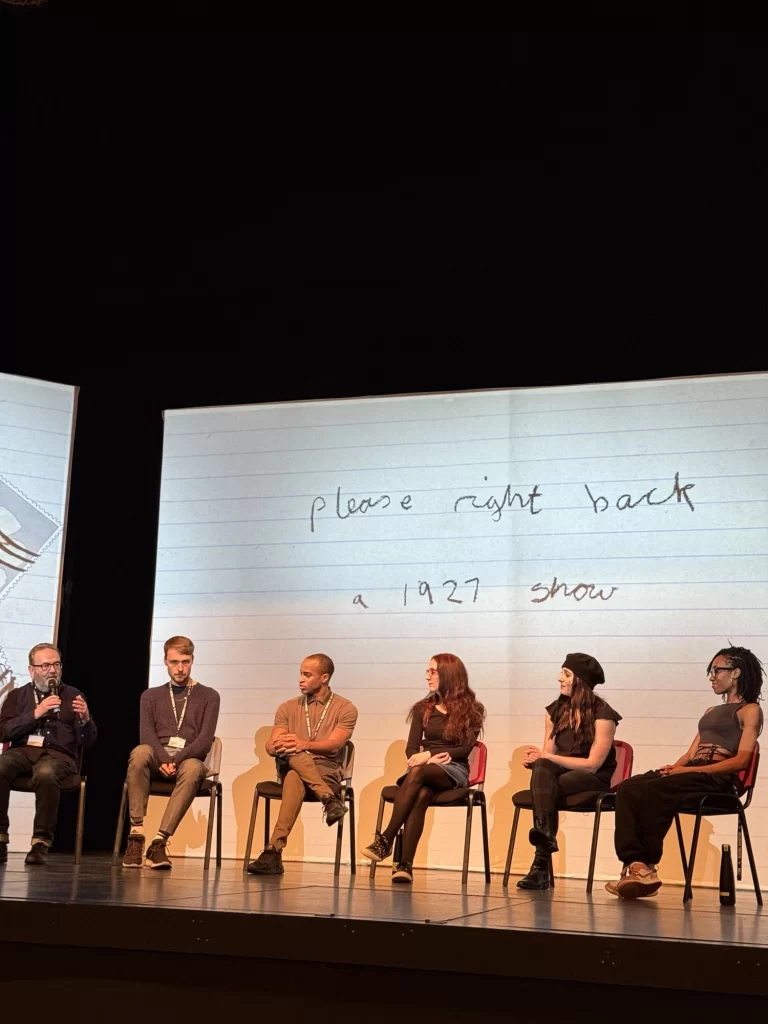Last Updated on Friday, May 2, 2025 by Lavania Oluban

Please Right Back, the newest creation from 1927, the award-winning company known for its innovative, genre-blending style, captivated audiences at Coventry’s Belgrade Theatre this weekend. This production offers a refreshing mix of social realism, science fiction, and fantasy, reminding us of the extraordinary power of imagination to help us navigate life’s most challenging moments. I have to say as we walked into the auditorium and I was given a pencil by a straight faced and speechless character in what looked like a wizard costume. I felt a little bit unnerved. I wasn’t quite sure what to expect from the show which suddenly erupted in front of us.
The story centers on Kim and Davey, two siblings who are left reeling after their father, Mr. E, suddenly disappears. Soon, letters start arriving from Mr. E, each one more fantastical than the last, as he describes his adventures in a surreal, animated world. These letters become a game and a bonding tool between him and his children, providing an imaginative escape from the pain of his absence. What makes this production especially poignant is that the story is inspired by the real life of co-director Suze Andrade, who discovered her own father’s letters from prison after he passed away. The phrase “Please right back,” taken directly from his letters, is woven into the heart of this story, including the misspelt word.

In true 1927 style, Please Right Back combines live-action performance with intricate, handcrafted animation by Paul Barritt, blending reality with fantasy in a way that feels both mischievous and immersive. The production features over 500 meticulously timed cues, handled by AV technician George, seamlessly integrating the animation with live actors. A unique rule in the production requires that any character under the age of 8 be animated, creating a hybridised family that “interacts fluidly with animated elements”, enhancing the story’s imaginative edge. On top of this the cast of just four actors play multiple roles each and this adds another layer of awe inspiring complexity.
With tales of espionage worthy of a Bond movie, and a French café scene with dancing onions, miming clowns, a singing ministry of Joy and a very unique cockatil bar in the Bermuda Triangle. You’d be forgiven for thinking this is a family show – but that is not with a capital F – yes there are many laughs, but there are so many adult themes which run through this performance which as a teacher made me think about many things from a different perspective. Looking at the situation of having a parent in prison through the eyes of both a teen and a younger child offers some valuable insight into the circumstances of many children in our society. The team do refer to it as a dysfunctional family show but also affirm that they have a dancing lion.
The interval was unusually quiet, I think most people around us were taking time to reflect and gather their thoughts. There were so many relatable moments, from accents to puns, and clever little titbits including interactions between characters and the animations, some very nuanced moments such as spotting the live actor playing a social worker kick the animated family cat as it was tangled up in her legs – a blink and you’ll miss it moment but one which had me seething with hatred for this character all over again.
I was really happy to be invited to join the cast and crew for a post show discussion following the performance and most of the audience stayed behind to find out more about how the show was put together. When you hear from the team about how much has gone in to making the show seem so effortless it gives you a new found respect for the creative process.
The cast and crew dedicated six weeks to this rehearsal-intensive production, a period of trial, experimentation, and collaboration. This distinctive style demanded a lot of patience, with actors alternating roles to fully understand the scenes behind them and refining scenes in the time just before shows with early call times. The collaboration extended to the actors’ physicality and interactions with two-dimensional, hand-crafted props, a hallmark of 1927’s style that draws inspiration from German Expressionism and silent films.
The company name ‘1927’ itself is a nod to the year The Jazz singer was released as the first spoken word movie.
The result is a production that feels both meticulously crafted and organically alive, in fact the team refer to it’s development as a sort of genesis.

Beyond the visual spectacle, Please Right Back prompts viewers to think deeply about larger issues. With underlying political themes, the play leaves audiences contemplating the challenges facing the family, educational systems, and social structures as a whole. The team has put a lot of effort in to the research and it all feels very current with some very clever quips relating to current events. True to 1927’s ethos, the production doesn’t attempt to answer every question it raises; instead, it invites viewers to ponder, long after the final scene has ended.
For theatre students and enthusiasts, Please Right Back is a masterclass in multimedia storytelling. The show’s use of 2D props and dynamic animation bridges traditional theatre with the world of early cinema, giving life to every gesture and scene. In fact, 1927’s distinct approach is a part of A-Level studies, and in the post show discussion with cast and crew we talked about upcoming resources the company are adding to make this production a valuable and inspiring experience for students exploring contemporary theatre.
In all, Please Right Back is a journey into a world where imagination becomes a lifeline. It’s a family story told with humor, creativity, and depth, underscored by 1927’s trademark touch of political and social insight. For those fortunate enough to experience it, the show is a reminder that storytelling and make-believe can be both a source of strength and a means of connection.


